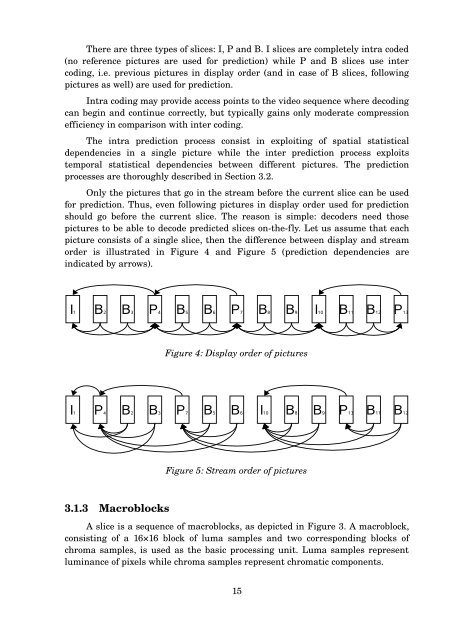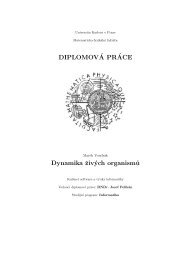MASTER THESIS Video Watermarking - Computer Graphics Group ...
MASTER THESIS Video Watermarking - Computer Graphics Group ...
MASTER THESIS Video Watermarking - Computer Graphics Group ...
You also want an ePaper? Increase the reach of your titles
YUMPU automatically turns print PDFs into web optimized ePapers that Google loves.
There are three types of slices: I, P and B. I slices are completely intra coded<br />
(no reference pictures are used for prediction) while P and B slices use inter<br />
coding, i.e. previous pictures in display order (and in case of B slices, following<br />
pictures as well) are used for prediction.<br />
Intra coding may provide access points to the video sequence where decoding<br />
can begin and continue correctly, but typically gains only moderate compression<br />
efficiency in comparison with inter coding.<br />
The intra prediction process consist in exploiting of spatial statistical<br />
dependencies in a single picture while the inter prediction process exploits<br />
temporal statistical dependencies between different pictures. The prediction<br />
processes are thoroughly described in Section 3.2.<br />
Only the pictures that go in the stream before the current slice can be used<br />
for prediction. Thus, even following pictures in display order used for prediction<br />
should go before the current slice. The reason is simple: decoders need those<br />
pictures to be able to decode predicted slices on-the-fly. Let us assume that each<br />
picture consists of a single slice, then the difference between display and stream<br />
order is illustrated in Figure 4 and Figure 5 (prediction dependencies are<br />
indicated by arrows).<br />
<br />
<br />
3.1.3 Macroblocks<br />
Figure 4: Display order of pictures<br />
<br />
Figure 5: Stream order of pictures<br />
A slice is a sequence of macroblocks, as depicted in Figure 3. A macroblock,<br />
consisting of a 16×16 block of luma samples and two corresponding blocks of<br />
chroma samples, is used as the basic processing unit. Luma samples represent<br />
luminance of pixels while chroma samples represent chromatic components.<br />
15
















